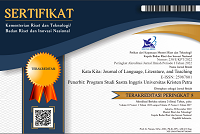Conversational Strategies Used by Kim Kardashian and Kris Jenner at The New York Times DealBook Conference
DOI:
https://doi.org/10.9744/katakita.11.3.416-424Keywords:
Belief System, Boundary System, Technology Acceptance Model, Implementasi ERP, dan Intellectual capital.Abstract
This study analyzed the conversational strategies of Kim Kardashian and Kris Jenner at The New York Times conference, focusing on their business-related discussions and exploring similarities and differences based on age and status. Following Coates' (2013) theory, seven strategy aspects were examined: minimal responses, hedges, tag questions, questions, commands and directives, swearing and taboo languages, and compliments. Using a descriptive qualitative approach, the study identified the strategies employed by each speaker. Kim Kardashian used five strategies, while Kris Jenner used six. Overall, the findings indicated more similarity than difference in their conversational strategies, suggesting there are influences from context, status, and age.
References
Coates, J. (2013). Women, men, and language (3rd ed.). Routledge.
Holmes, J. (2013). An introduction to sociolinguistics (4th ed.). Routledge.
New York Times Events. (2019, November 6). Kim Kardashian and Kris Jenner discuss their family’s legacy, the dangers of social media, and more [Video]. YouTube.
The Business of Fashion. (2022b, July 20). Kris Jenner is part of the global fashion industry.
https://www.businessoffashion.com/community/people/kris-jenner
Tikkanen, A. (2022, October 17). Kim Kardashian. Encyclopædia Britannica.
https://www.britannica.com/biography/Kim-Kardashian
Xu, L. (2009). Power adjustment in professional women’s language: An investigation into the use of directives in the TV-series Cashmere Mafia. [Undergraduate thesis, Kristianstad University]. DIVA Portal.
Downloads
Published
Issue
Section
License
Authors who publish with this journal agree to the following terms:- Authors retain copyright and grant the journal right of first publication with the work simultaneously licensed under a Creative Commons Attribution License that allows others to share the work with an acknowledgement of the work's authorship and initial publication in this journal.
- Authors are able to enter into separate, additional contractual arrangements for the non-exclusive distribution of the journal's published version of the work (e.g., post it to an institutional repository or publish it in a book), with an acknowledgement of its initial publication in this journal.
- Authors are permitted and encouraged to post their work online (e.g., in institutional repositories or on their website) prior to and during the submission process, as it can lead to productive exchanges, as well as earlier and greater citation of published work (See The Effect of Open Access).














